-
Posts
248 -
Joined
-
Last visited
Posts posted by Boris Belay
-
-
Hi Travis,
As far as starting an ACL with a new mag (or a mag that was taken off), there is no reason to worry about the speed on the motor. If the perf on the new mag is not caught by the claw on its first rotation, it will be on the second, no matter the speed (so long as your camera's claw is set up properly). And film is designed to take the impact of the claw.
As Gregg mention, you can inch the motor manually to catch that perf, but it's not nevessary either, and will not help with the loop : inching by hand or running the motor will in both cases possibly miss the perf the first time around. Because of this, I usually tell people to make the top loop a tiny bit longer (1 frame, if you have to count), rather than a bit shorter.
Remember that these cameras (and most film cameras of the News-gathering-on-film generation) were designed for ease of use by cameramen who only cared so much about their TV station's equipment. They were expected to catch events on the go, not bother with minute details about loading procedures. The Eclair 5-second magazine change was not just a marketing plot !
-
-
Hi Duncan, I'm not sure your motor is a Tobin model. I would think it's an OEH model which may have been modified to accept the Tobin Miliframe controler ( a much more recent design). The controler, I believe, only sends a crystal signal to the motor, so it would be easy to wire the special (fiddly) Tobin female connector to any motor designed to receive an externale synch signal.
As for the Perfectone Compact motor, it's a different beast altogether, and an older design (although it was their second design for the NPR). Their casing was definitely metallic and I suspect the company was not around when OEH and later Tobin copied their fairly obvious design (from an era before copyright infringement madness).
Here's some info on the Perfectone Compact :
-
 1
1
-
-
And finally, the front housing, with its offset lens opening.
Everything ese about the camera is pretty much standard NPR, including the motor (not an Aaton Alcan like yours). It even had the early Kinoptik viewfinder.
It came with one magazine that had been converted too, but as far as I remember, it was mostly the main roller on the take-up side. I did not take pictures, unfortunately.
I sold the camera to a person in Brussels about a year and a half ago, who used it on a shoot in Greece with good results. I think he may want to sell it back, in case somebody is interested.
Obviously, this is a Super-16 only camera, since the centering is fixed. The ground glass has 4/3 markings, but the lens is centered for S-16 (not a problem for most lenses).
Of course, Eclair did try to make a Standard 16/Super-16 switchable camera, the Panoram, but it never went beyond the prototype stage...
-
 1
1
-
-
-
-
-
Thanks Duncan, that's a lot of great scanning you have done here. I will check in my files to see whether I have something else to add.
Boris
-
 1
1
-
-
Patricia, if you are still reading this thread (sorry for the delay) : if I understand your point, the led below the middle one is always on ? If that is the case, it's obviously stuck as it should come off when the exposure is correct and especially when over-exposing.
There is a procedure to calibrate the light-meter properly so that it covers all the expected ISO settings, it was meant for installing a new lightmeter in a camera. But I don't think this is what you are describing.
If I misunderstand your question, let me know.
Boris
-
Hi Duncan, Sorry, I have not been on this site for a while so I missed your original posting. Nice camera, especially with its Aaton motor, but I'm pretty sure it's not a factory S-16 camera, and nearly sure it's a Van Diemen job. I had a factory S-16 NPR (now sold) and it was different in several respects (no N-16/S-16 option, for instance), and it definitely had a factory S-16 ground glass, while yours has a ground glass that looks a lot like the one I had on a Van Diemen Aaton S-16 conversion.
Van Diemen made very nice conversions, so it's really not a big difference, but I had to rectify that for the record. I think I have pictures of that camera somewhere, so I will post them.
-
 2
2
-
-
Hi Marek,
Can you tell me more about your GV-16 motors ? Which type/brand are they ?
I may be interested in one if cheap... I don't plan on using my GV-16, just complete it for completeness' sake. Or I could sell it if you're interested.
Best, B.
-
Hello Marko, I just saw this thread... Nice lens indeed ! Funny you should have had it bundled with an Arri camera when a CA lens can't even be adapted to an Arri camera (while the reverse its possible).
I have an unmarked Kinoptik lens which I believe is similar to yours (it's unmarked) and I was wondering whether you still had yours because I would like to compare the size of the front and back lens.
Would you have a moment to measure them for me ?
Thanks !
-
Hello Amaury,
I don't have the exact mesurements at hand right now, but the NPR/Coutant is quite a beast, especially with that motor (there is a later Aaton-built motor that is quite a bit shorter). Off the top of my head, I vould say the camera is at least 50 cm tall, maybe 60.
The next issue is weather that tripod system would hold the weight of the camera properly...
By the way, I'm in Brussels and I repair Eclair cameras, so don't hesitate to let me know if you'd like to drop in for a chat.
Best,
Boris
-
Hi Gregg,
Sorry for the late answer but the answer is yes, and no ;-)
Yes, there is, you can see it in your VF if it has a lightmeter built-in : it's the center circle that is slightly yellowish, or at least darker. That is where some of the GG light is diverted to the lightmeter cell.
So, yes, there is some light loss, as you can see, but only in that center spot.
Removing the Lightmetering system does not help, since the center spot pellicle is built into the GG and prism optical block. Not sure why sme technicians remove it for S-16 conversion, it's not necessary and it's a pretty useful feature of the camera. Some ACLs never had it, by the way, it was a factory option. I have one of the last ACL II and it didn't have a lightmeter built in (so no center spot either).
And yes, you are right, the lightmeter is described in detail, with schema, in the mid-70's user manual (the one that most people have).
Cheers,
Boris
-
I just bought a used Eclair NPR, as a B-cam for one I already own, in preparation for a documentary shoot later this year. the b-cam runs a tad noisier, and vibrates slightly, which tells me it may be due for some servicing.
Being that it's a B-cam, and considering I don't have a ton of money on hand just now to ship it off to a pro, I thought it might be a good opportunity for me to gain a greater understanding of how my camera works, and I'm interested in taking a crack at doing some work on it myself.
Anyone have experience at this, working on a disassembled NPR? Any recommendations, suggestions or warnings? Are there available servicing manuals that might help educate and guide me in this process?
Thanks!
BR
Hi Brian,
I'm pretty sure that there is a NPR Spare Parts manual floating on eBay at the moment. This is just about all you are likely to find as technical documentation on that camera (as far as I know, but I have looked for 7 or 8 years now). I recommend you get this first, study it, and then make up your mind as far as how much you want to get into the internals of the camera.
Some parts are easily taken off, like the motor assembly (meant to be swappable in the field), so that may be a first step. Obviously, you'd want to be confident about your mechanical skills before anything else.
In case you do want to get in there, my first recommendation is to get good tools, and in particular a very good set of fine to medium straight screwdrivers. Most Eclair screws have a very narrow head slot, and since the camera is old, it is easy to destroy those heads and leave you with a screw stuck in place if you don't have a screwdriver of the right size and in good shape. Eclair made their own screws, so don't expect to easily find replacements.
Cheers,
Boris
-
Hi Giorgio, Just a few prototypes... They were shown at Photokina 1982. I have actually seen one ;-)
As for the value of the camera, very hard to tell (too few built, unknown real-world operatability,...), not to mention the upheavals in the 16mm market today !
Ciao, Boris
-
The "cat-on-shoulder" marketing claim is really steeped in history, and comes from a time when shoulder designs were still rare as 16mm cameras where mostly handheld in front of the operator, 1950s-style. Think: Arriflex 16 St or 16 BL (Tim is the master of 16 S knowledge B) ).
The comparisons made by others here with flatbase cameras like the Arriflex 16 SR-series is spot-on in terms of the "comfort" camera operators can now benefit from thanks to "cat-on-shoulder", but actually it's a bit of an anachronistic comparison because the SR was presented in 1975, years after Jean-Pierre Beauviala had presented/launched the Aaton 7 back in 1971/3.
In fact, André Coutant's Eclair 16 NPR of 1963 was the first shoulder-design camera, and the much-delayed Eclair ACL - already designed by Jean-Pierre Beauviala - developed this form factor further into what Aäton now basically markets as "cat-on-shoulder" ergonomics. The ACL is basically the sketch from which JPB created the Aaton 7 and laid the foundation for his own company.
In a way, even after "cat-on-shoulder" was established as the preferred form factor for film-based newsgathering cameras by the mid-1970s, ARRI still had the boldness to bring their own very unergonomic design to market that they only ditched with the 416 roughly three decades later :huh: .
Personally, I think the Aatons are still the best cameras to have on your shoulder for any longer time, and the most ergonomic ones to operate. Better than the ACL or similar cameras like the CP 16, News 16 or even the 416. The only camera coming close to the Aatons is in my view the Bolex 16 Pro, a camera introduced in 1970 ahead of the ACL and Aaton which few people know.
Sorry for this rant, people, but I can't let so many errors in so few paragraphs go unchecked -- ciinematography.com will only remain a bit authoritative if we don't let 'anything go' with respect to information, albeit historical (but perhaps historically accurate information and the perspective that comes from it is the thing we need most in the face of the ongoing technological upheaval in the field of image production...). So here goes :
'The cat on the shoulder' marketing claim was actually Aaton's very own, dating to the mid 70's, by which time many camera designs were shoulder-held. I was meant to advertise a better, more ergonomic design, not just any shoulder-holding (and the target was probably more Eclair than Arri in that respect : Eclair does it well, we do it better!)
The Eclair 16 was by no means the first shoulder-held camera : just think of Eclair's own 1947 design, the Caméflex
Jean-Pierre Beauviala had nothing to do with the design of the Eclair ACL, which was designed by Coma and Lecœur.
The ACL was not 'much delayed'. In fact, it's the Aaton 7 that was 'much delayed', and I'm pretty sure (although I'm ready to be corrected on that), date-wise, it was more like 'announce and '73 and produced in '75), making it a contemporary of the Arri SR.
And to give back Beauviala his due, if the ACL was not his 'sketch' for the Aaton 7, he certainly looked at it closely and had one briliant idea to improved on its ergonomics : to move the viewfinder in front of the camera (rather than on its side as on the ACL and many previous designs), so that the body of the camera could be moved back and better balanced, weight-wise, on the shoulder -- that's the genius behind the cat on the shoulder ergonomics of Aaton cameras. Paradoxically, it's also what nearly brought Aaaton's demise when, after much delay, the Aaton 7 was released in the same time frame as the Arri SR (which also has that forward V-F design)and Arri decided to sue Aaton on patent infringement. Putting its great financial weight behind the legal procedure, Arri did bring Aaton to its knees, but Beauviala is also an astute entrepreneur and managed to get his company back on its feet after only a short while.
Voilà, end of my rant. But please, Michael, check your facts before posting, next time.
-
 1
1
-
-
Hi Steve,
I probably have an exploded view of some model of the R16 somewhere. If interested, send me a PM with your e-mail address and I will check.
B
-
HI, Yes, that looks like a decent battery. At 12Ah, it should last for quite a while -- more than you're likely to ever use on any single day's shoot.
Basically, all you need is a Lead Acid 12V. battery of 4Ah or more and a power cord terminated by an XLR-4 female connector (pin 1 is ground, pin 4 is 12V.). Lead acid batteries are cheap and solid, and they come in many sizes (and amperage). THey are the same that are used in cars, but smaller -- often used in R-C model airplanes, cars; etc.
Best, B.
-
Ciao Giorgio,
To me, this camera looks like a 1976/1977 model that had an ACL II base added later. Everything coresponds to the late 70's model : motor, viewfinder, small details on the body... Also, the ergonomic handgrip and its attachment on the body are not standard, so they were also probably added later.
Look at all the info that I put on eclair16.com to help with the dating of these cameras, and a lot more info too. Regarding the viewfinder, yes it is removable easily. But yes, if you want to trade it for another kind of ACL viewfinder; you have to have the matching mount. If you do, it's easy, as it's only attached with two screws.
CIao, Boris
-
After you read the ACL II literature carefully, you get this info:
Optics
The ACL II's patented universal lens mount system consists
of a threaded "C" mount receptacle (mechanical back focal
distance of 17.52mm) set flush into the camera body face,
surrounded by a collar of raised threads of larger diameter.
Camera mounts with a stainless steel collar can quickly be
locked into position on the raised threads. You can use any of
the well-known professional lenses with accessory camera
mounts that fit the raised threads. Including, of course, the
heavy-duty Eclair CA-1 bayonet lens mount, (mechanical
back focal distance of 48mm) which is supplied standard with
the camera.
These are no mere adaptors. Lenses are rigidly and precisely
held against the camera face. So you can use zooms, or
other long or heavy lenses without any other lens supports.
A slot for gelatine filters is set into the camera body between
the lens mount and the reflex mirror. So there is no need for
separate filters for each lens, and you can see the filter through
the viewfinder.
So, I understand from this statement, the support is only needed when the lenses are threaded on the C-mount.
Hi Erkan,
That's on principle... Bu the Ange 12-240 is truly a heavy lens. I think I would use a lens support with it myself.
I have a couple of custom made models I picked up with ACL kits. If interested, send me an email at bobolex@gmail.com
Best to you in lovely Instanbul ;-)
B.
-
Is it possible to take a 100' roll of film out of the Eclair NPR magazine? I loaded the film into the mag, found out I could not shoot that night due to a lens issue, and now there is a 100' daylight spool of b&w film in the magazine. How do I take it out?
Hi,
Yes, you can... In a black bag, of course.
Either unthread the begining of the film and spool it back onto its daylight spool, or cut the film where it enters the light chamber on the spooling side (you will lost a couple of feet, but it's simpler -- just don't forget to put scissors into your changing bag !).
Cheers,
B.
-
The magazine test stock was old Ferania with sound stripe. Replacing that with some 1995 Kodak neg the problem dissapeared. I can't explain that. I have two 400' magazines here that look like they did a lot of work early in life and had frequent service. Maybe the "shoes" to drive sprocket alignment is affected by that. The steps for the screw heads are a bit worn.
Cheers,
Gregg
Hi Gregg,
That Ferania stock was probably too old and became too stiff to move through the mag properly. Not to mention it's Italian mad ;-)
No seriously, old stock is always more rigid than fresh stock, more noisy, etc. I've never tested any sound-stripped stock, but it may even add to the problem.
Time to test all of these mags with fresh film ! THe best would be to spool 200 or 400 ft on a large daylight spool (do you have one?) and test all the mags with the same roll (filming a board with the mag serial number at the beg. of each take, to keep track of which is which). You definitely don't need to shoot 100ft per mag to test them.
But do take them out into the sunlight light (I know it's winter in NZ, but hopefully you still get more sun than we do in dreadful Belgian Summer...) and test for real-world light leaks.
How are the mag-nose rubber seals, by the way ? I have to look for a good source of them, since these old mags are usually in sore need of new seals.
Best,
B.
-
Hey Daniel,
My rotation to lock is about from 12 noon 'till 1 oclock if it's lucky. Maybe 20 degrees. I think there may be a bur on the edge of the chanel that the little Arri B wing fits into.
Cheers,
Gregg.
Hi Gregg,
These adapters were designed for the NPR and the Caméflex, which didn't have the optional mounts of the ACL. They're not as good, but should be fine nevertheless.
Check the mating surfaces on the lens seat and on the adapter front : that's what's critical for FFD.
As for the lens seating, if it's tight, with no play, you're good.
If you only have one Arri B mount, you could also leave the adapter on the lend (some have set screws in them to fasten them to the Arri B mount) ans treat the lens as a CA mount lens.
Cheers,
B.



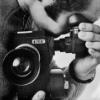
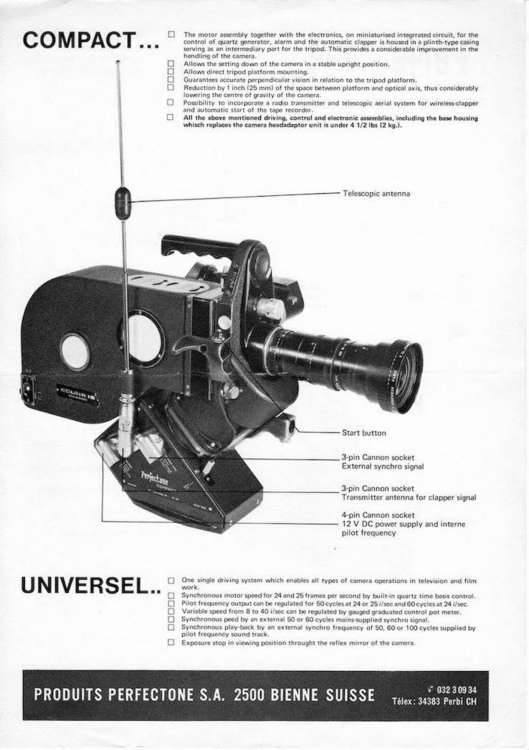
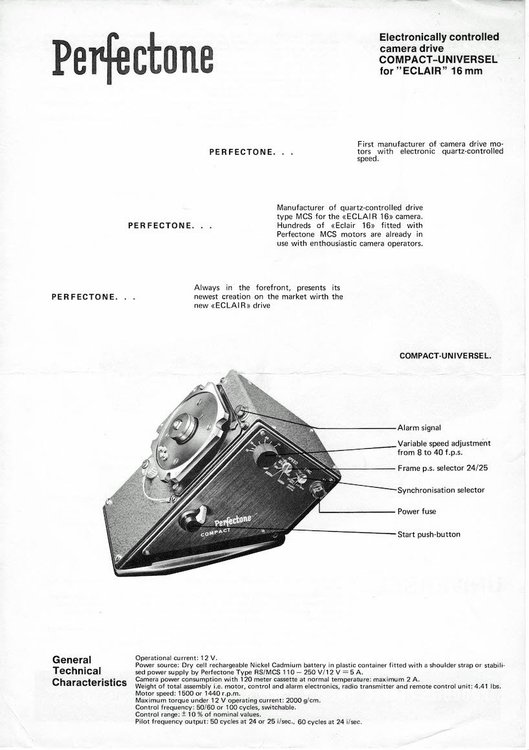
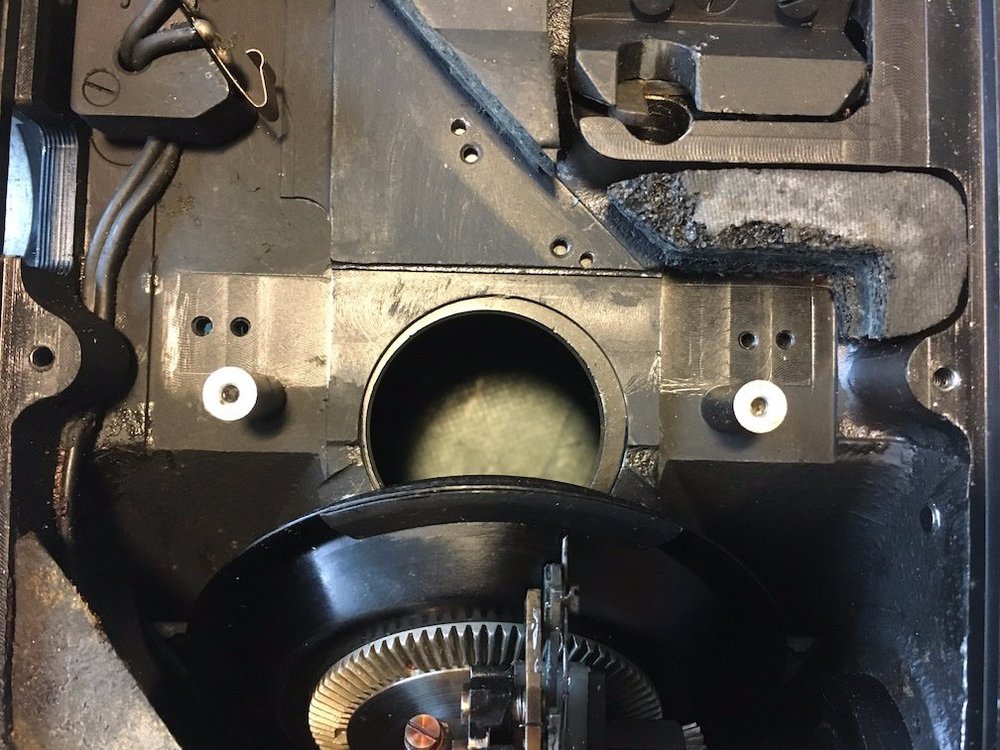


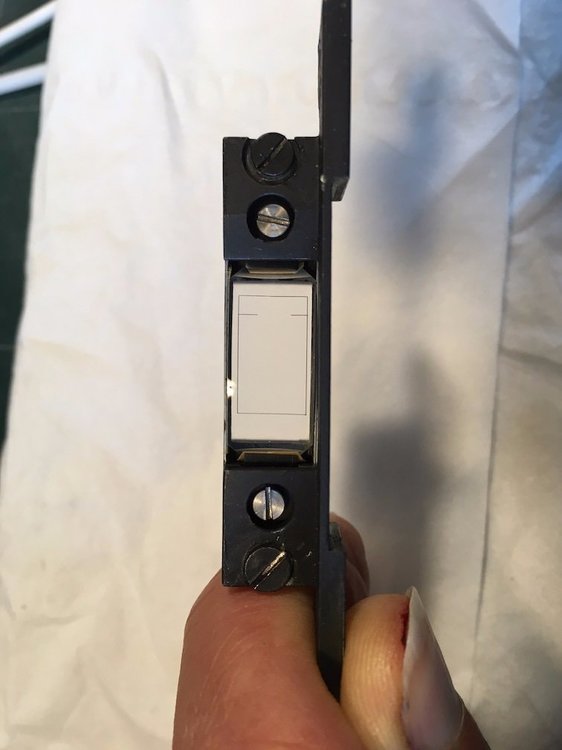
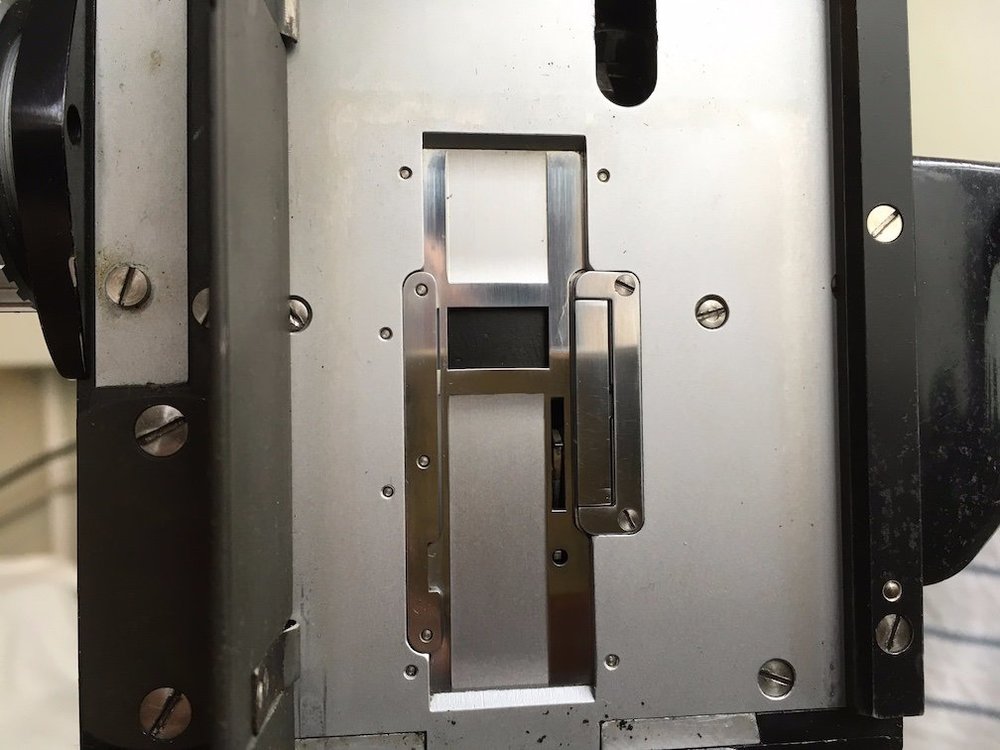
Phasing?
in Eclair
Posted
BTW, I'm not sure what you mean in this particular context by 'phasing' or 'phase function', which has to do with syncronising two cycles together. But in case somebody visits this thread hoping to find out something about phasing on the ACL, it is indeed a function that was built into the electronics of the ACL II (and only the ACL II).
The Lemo connector (6-pin hermaphrodite) in the bottom base of the ACL II (and absent from earlier tall base ACLs) is desighed to receive an external synch signal that controls the last series of ACL motors (code MIPIL, with silver and black locking speed button) when it is on the 'E' speed setting (for External).
Eclair made a very rare accessory box to plug into this connector and receive an external signal. This BOTEX accessory has a phase correction function to precisely adjust the shutter phase to the external signal. This was mostly used at the time when filming a CRT (TV, etc.), as the phase adjustement could move the black bar out of the image (with the main speed being synchronised by a feed from the TV.
Here are some images of the rare beast :